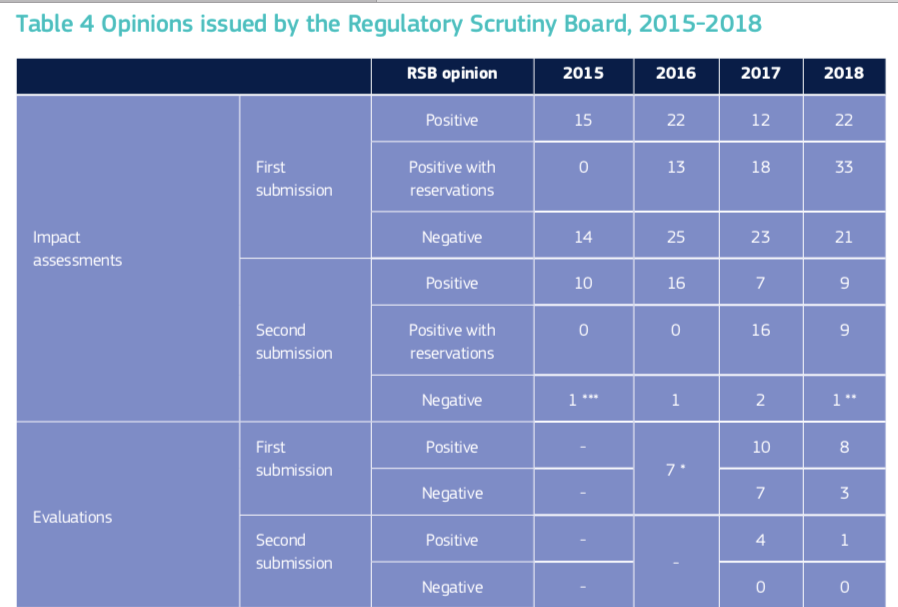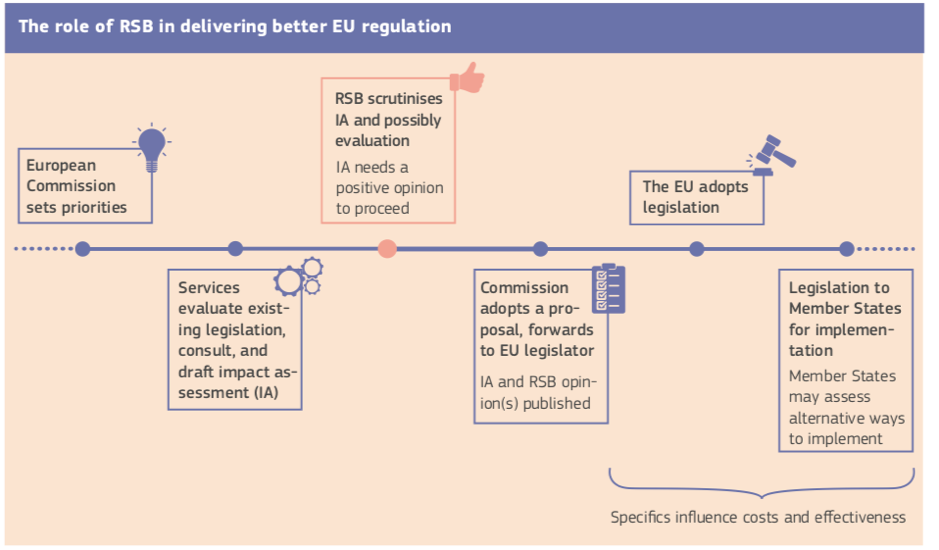Part 1 of a series of posts reflecting the old working methods and working with the Commission.
Regulatory Scrutiny Board
The Regulatory Scrutiny Board (RSB) is an independent body within the Commission which scrutinises the quality of impact assessments, evaluations and fitness checks.
The membership is 6 people plus the chair. They serve for a three-year term. It is not renewable. Three of the members and the chair come from the Commission, and the other three are recruited externally. The members are here.
They are independent of the Commission. They take no instructions from inside of the Commission or outside.
The RSB Rules of Procedure are here. Their work is supported from a small secretariat drawn from the Secretariat-General.
As a general rule, they review all impact assessments, all fitness checks and selected evaluations. You can find the opinions on the impact assessments here and the evaluations on the evaluations and fitness checks here. They are used for the important “Commission initiatives that are likely to have significant economic, environmental or social impacts”.
The phrase “significant … impacts” lacks granularity. You get a good sense of what it covers by looking at the proposals that have been called in for an impact assessment. That said, there is inherent flexibility provided to the Commission’s Secretariat-General to make that determination. The final determination does not sit with the lead DG. There are many files that the lead DG were instructed to perform an Impact Assessment, despite their vocal protestations.
Impact Assessments are used for both legislative and non-legislative initiatives, as well as delegated acts, implementing measures and RPS measures.
The 2018 Stocking Report (link) provides a good idea of the workload:

Stocktaking report 2018, p.26. Link.
What do the RSB need and when do they need it?
For Impact Assessments, the toolbox spells out what is needed, from whom and by when:
“What
- A note signed by the Director-General of the lead DG addressed to the chair of the RSB.
- Draft IA report (SWD).
- IA summary sheet accompanying the IA report (SWD).
- Minutes of the meeting of the inter-service group that has been preparing the IA report immediately prior to submission of the IA report to the RSB.
- Links to where important underlying reports or studies can be found which underpin the IA report.
- Underlying evaluation SWD, if this evaluation has not been scrutinised separately by the RSB.
When
- The lead DG should reserve a slot at a future meeting of the RSB at which the IA report will be discussed. In general, the slot should be reserved at least 3 months before the RSB meeting.
- This slot should reflect the envisaged timing of the political initiative, the time needed to adapt the IA report in light of the Board’s opinion(s) and the time needed to complete a formal inter-service consultation and formal adoption by the College.
- The draft IA report should be submitted to the RSB at least 4 weeks before the RSB meeting where the draft IA report will be discussed.
- In a few exceptional cases, the RSB may decide that the draft impact assessment report does not need to be discussed at a formal meeting of the Board but can be dealt with via written procedure. This can only be decided on a case-by-case basis once the draft IA report has been submitted to the RSB and will depend on the quality and lack of complexity of the case at hand.”
The chart below shows you when the RSB steps into the adoption process.

A screening mechanism
The RSB provides an important screening device. It helps filter out poor and sloppy thinking. The RSB can be merciless in highlighting flaws in the thinking. In one case, the RSB highlighted out that the preferred solution of the lead DG was not provided for in the legislation, not asked for, and not supported by any evidence presented in the public consultation. The Impact Assessment received a negative opinion and needed a lot of re-work.
Poor thinking is often exposed when services decide to prepare the impact assessment (and proposal). Even if a Commissioner and Vice-President pre-decide an outcome in advance, they may find that there is no real facts or evidence to support their preferred outcome.
The RSB are experienced at filtering out poor thinking and pre-determined political decisions. A proposal cannot usually go forward if there is a negative opinion.
Exceptions to the general rule
As a general rule, a proposal can only proceed to inter-service consultation after approval from RSB. From time to time, the RSB has issued two negative decisions. In those rare cases, the decision to take the proposal forward lays with the President. One such proposal is the taxonomy on sustainable finance. These exceptions are provided for in the rules.
The Regulatory Scrutiny Board does not look at every proposal. Most, although not all Commission proposals in the Work Programme need an Impact Assessment. From 2015 to 2018, 28% of Commission proposals did not have an Impact Assessment. The Commission’s assessment is that for 19.5%, their own rules did not require them.
The Commission state that between 2015 and 2018, 8,5% of Commission proposals linked to the Commission Work Programme were not accompanied by an impact assessment when one would have expected it.
Between the period 2015-2018, there were 3 instances when the Commission took the political decision to go forward with an initiative despite the absence of a positive Board opinion vouching for the adequateness of the underlying impact assessment. As mentioned, this is foreseen in the guidelines.
Exceptions were granted for the remaining 8.5% cases. These were time-sensitive files linked to the migration, security and economic crisis. In 7% of all cases, the formal reasons for invoking the exception was never given.
When is the proposal written?
Good practice is that the same inter-service group that prepared the IA will also look informally at the legal text before the formal inter-service consultation is launched.
When can you read the RSB’s Opinion
The RSB’s Opinion is published once the ‘initiative has been decided by the Commission’ (see page 16, Toolbox 3).
All impact assessments and the related opinions of the Board are published online once the Commission has adopted the relevant proposal.
For Ordinary Legislative Proposal, the Impact Assessment and Opinion are released at the start of the legislative journey. They are published along with the legislative proposal sent to the European Parliament and Council.
For secondary legislation, the impact assessment is made public at the end of the legislative journey, and only when the Commission adopts the draft measure. This practice is contrary to the advice of the European Court.
This means the intellectual foundation, or the lack of, behind the Commission’s proposal is kept away from public scrutiny until it is too late. Any errors in the impact assessment can’t be raised at the right time.
As secondary legislation is around 97% of the Commission legislative output, you can understand why some officials may want to keep the public in the dark. If you can’t see the impact assessment until after it is sent to the EP and Council for ‘scrutiny’, your life is going to be a lot easier.
Secondary v Ordinary
Example 1: Eco-design requirement for air heating products – Secondary Procedure: RPS
June 2009: Commission launch preparatory study
19 February 2014: Impact Assessment Board Opinion (link)
13 August 2015: WTO Notification
15 September 2015: WTO Notification period ends
8 December 2015: Committee on the Ecodesign and Energy Labelling of Energy-using Products approve
23 April 2016: Scrutiny Deadline for EP and Council
30 November 2016: Commission adopts draft measure
30 November 2016: Impact Assessment published
20 December 2016: Commission Regulation published in Official Journal
Example 2: Electricity Market Design (Electricity Regulation) – procedure: ordinary
October 2015: Inception Impact Assessment launched
16 September 2016: RSB issue negative opinion
7 November 2016: RSB issue revised positive opinion
30 November 2016: Proposal on the Internal Market for electricity
30 November 2016: Impact Assessment published
How you can influence the RSB
A good lobbyist knows when to lobby and, more importantly, when not to lobby Just as you would not lobby judges ruling on your case, it stands to reasons you would not try and lobby the RSB.
The Board’s own rules of procedure make it really clear they should not be approached and their work is confidential.
There is a very easy way to positively influence them. Better Regulation’s Public Consultations needs lots of good data and information to prove a case. So, the best way you can influence the RSB is to make an excellent submission.
You should focus on proving your case by reference to the Commission’s very own Guidelines and Tool Box and sending up a crystal clear case, full of data and evidence, to support your case.
That said, too often, the quality of the submissions from third Parties is too weak and asks for things that are outside the remit of Better Regulation.
Fail-Safe Mechanisms?
If a poor proposal gets through what can you do? The First Vice-President and President always have the discretion for not letting a poor proposal get adopted. It is unclear if that discretion has been used for some time.